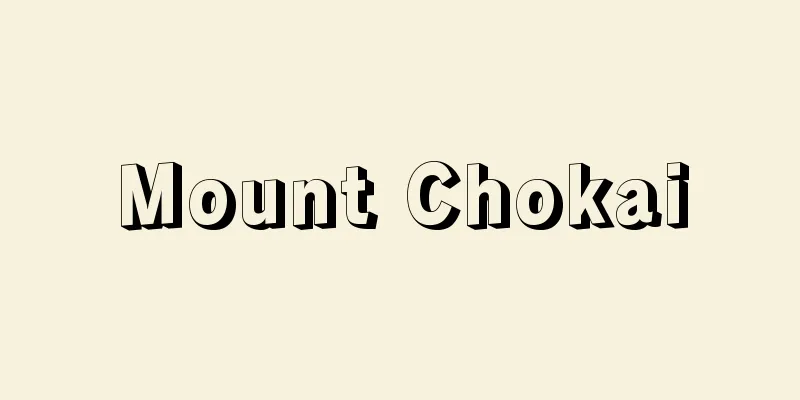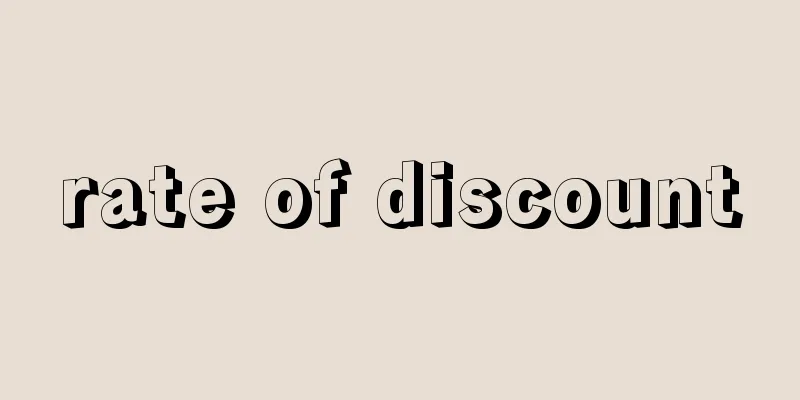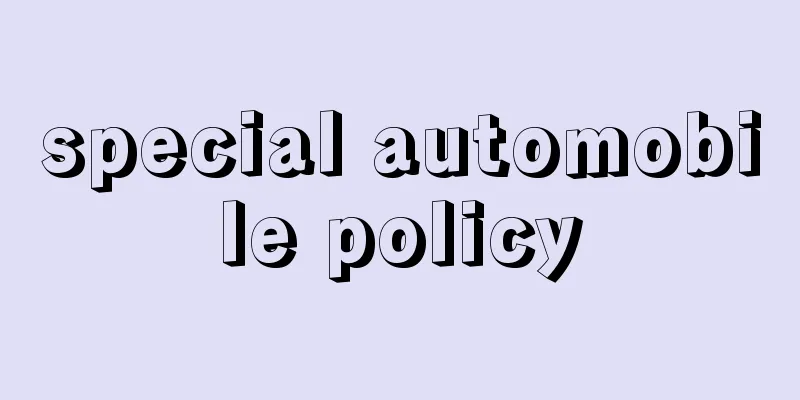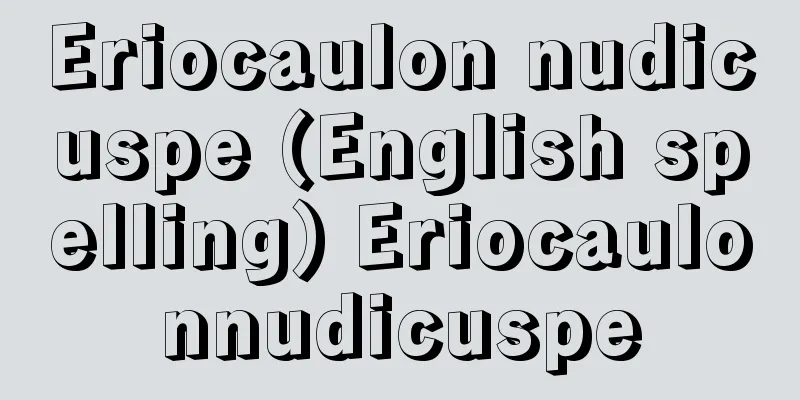Automobile insurance - jidoushahoken
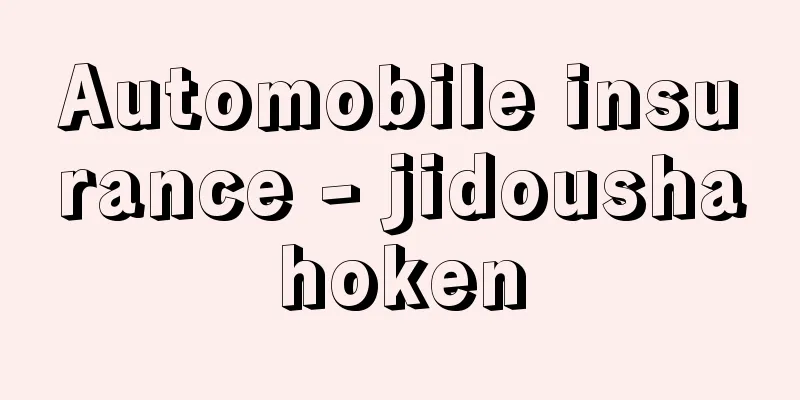
|
Insurance intended to compensate for bodily injury and property damage caused by automobile accidents, etc. This is a type of non-life insurance that compensates for damage caused to the body or life of others or property damage caused by owning, using, or managing an automobile or motorized bicycle (generally a two-wheeled vehicle of 50cc or less), injuries (including permanent disability or death) to the driver or passengers in an accident while riding an automobile or motorized bicycle, vehicle accidents (collision, contact, fall, overturning, fire, explosion, typhoon, flood, high tide, and other accidental accidents), and theft. [Naoshi Oshio March 19, 2018] historyAutomobile insurance was first commercialized and entered the market in 1896 by the Law Accident Insurance Society in the UK. The following year, in 1897, the American Travelers Insurance Company also began selling auto insurance. In Japan, Tokio Marine Insurance (later Tokio Marine & Nichido Fire Insurance, now Tokio Marine & Nichido Fire Insurance) was licensed to do business in 1914 (Taisho 3). Automobile insurance has developed against the backdrop of rising social awareness of liability for compensation to victims of automobile accidents and respect for human life, as well as the introduction of compulsory insurance to provide relief to victims. In Japan, the Automobile Liability Security Act (abbreviated as Automobile Liability Act) was enacted in 1955 (Showa 30) with the aim of providing relief to victims, and Automobile Liability Insurance (abbreviated as Automobile Liability Insurance) was implemented the following year. During the period of high economic growth, traffic accidents increased sharply, and optional automobile insurance was developed that included various types of compensation not covered by compulsory automobile liability insurance, leading to fierce sales competition among non-life insurance companies. Automobile insurance, including compulsory automobile liability insurance, accounted for more than 50% of income premiums in the late 1980s, and grew to become the main product of non-life insurance companies. Since insurance deregulation, differentiation of automobile insurance prices and products has progressed. [Naoshi Oshio March 19, 2018] Compulsory and voluntary insuranceAutomobile insurance is divided into compulsory insurance and optional insurance. Compulsory automobile insurance is compulsory insurance that all automobile owners are required to enroll in based on the aforementioned Automobile Liability Act (only personal liability insurance). Since compulsory automobile liability insurance was introduced for policy purposes, it is operated on the no-loss, no-profit principle (the idea of balancing income and expenditure with appropriate insurance rates so as to neither make a loss nor a profit). Compulsory automobile liability insurance has a maximum limit of 30 million yen for death benefits, 40 million yen for disability benefits, and 1.2 million yen for injury benefits. These are only maximum limits, and the amount paid is determined according to the circumstances of the accident and the victim's characteristics. In the event of a personal injury accident caused by driving a car, damages are paid first from compulsory automobile liability insurance, but if that is not enough, the difference is paid from personal liability insurance in optional automobile insurance. Compulsory automobile liability insurance played a role in developing the automobile insurance market until the mid-1960s. As motorization (development of automobile traffic) progressed, the number of traffic accidents also increased sharply, and traffic hazards became a social problem, leading to an increased awareness of compensation. However, the payment limit for compulsory automobile liability insurance was kept low as a matter of policy, promoting the development of optional automobile insurance. Voluntary automobile insurance contracts are divided into fleet contracts (insurance contracts for 10 or more owned/used automobiles) and non-fleet contracts (insurance contracts for 9 or fewer automobiles) depending on the number of vehicles owned. Personal automobile insurance is a non-fleet contract. For individuals, there is bodily injury liability insurance, property damage liability insurance, automobile insurance-specific personal injury insurance such as passenger injury insurance, uninsured motorist injury insurance, self-inflicted accident insurance, personal injury compensation insurance, and vehicle insurance, as well as various special clauses (contracts that are added as options to the main automobile insurance contract) such as other vehicle driving risk coverage, family-only special clause, family bike special clause, and loaner car cost coverage special clause. [Naoshi Oshio March 19, 2018] Any type of car insuranceSince automobile accidents often involve multiple overlapping losses, comprehensive insurance (set insurance) is usually offered. For example, there are basic automobile policy (BAP), package automobile policy (PAP), special automobile policy (SAP), and comprehensive automobile policy. BAP is an insurance that you can choose the type of automobile insurance you want to subscribe to, but as a basic contract, you must subscribe to one of the following: personal liability insurance, property damage liability insurance, or vehicle insurance. If you subscribe to personal liability insurance, self-inflicted accident insurance is automatically included. It is up to the policyholder to decide whether to combine other insurances. PAP is an insurance that can be taken out not only for private cars but also for commercial cars and motorcycles, and is a set of personal liability insurance, property damage liability insurance, passenger injury insurance, self-inflicted accident insurance, and uninsured motorist injury insurance. SAP is an insurance package that includes personal injury liability insurance, property damage liability insurance, passenger injury insurance, self-inflicted accident insurance, uninsured motorist injury insurance, and vehicle insurance. Comprehensive automobile insurance is a set of insurance that includes bodily injury liability insurance, property damage liability insurance, personal injury compensation insurance, and vehicle insurance. Comprehensive automobile insurance was originally abbreviated to TAP (Tokyo automobile policy) because it was developed by Tokio Marine & Nichido Fire Insurance Co., Ltd., but since insurance products do not have patent rights, each company has started to handle products with the same structure, and now it has a variety of names. Incidentally, Tokio Marine & Nichido Fire Insurance Co., Ltd. merged with Nichido Fire Insurance Co., Ltd. in October 2004 to become Tokio Marine & Nichido Fire Insurance Co., Ltd. (abbreviated as Tokio Marine & Nichido), and since Tokio Marine & Nichido names all personal insurance as Total Assist, Comprehensive automobile insurance was changed to "Total Assist automobile insurance." Automobile insurance uses a rating system to ensure fairness for drivers based on their level of risk (whether or not they have a history of accidents). Normally, there are 20 ratings (the highest is rating 20, which has a discount rate of over 60%, and the lowest is rating 1, which has a surcharge rate of over 60%), with new policyholders being in rating 6. If there are no accidents and no claims made during the one-year contract period, the no-accident coefficient is applied, and the driver's insurance premium for the following year is discounted by a certain percentage, but conversely, if an accident occurs and a claim is made, the driver's insurance premium is reduced by three ratings, the accident coefficient is applied, and a surcharge is imposed. [Naoshi Oshio March 19, 2018] Automobile insurance from a non-life insurance companyAfter the period of high economic growth, major non-life insurance companies shifted their management strategy from one that had focused on the commercial insurance sector to one that focused on automobile insurance for households, a so-called popularization approach. Automobile insurance grew to become the main product of non-life insurance companies from around the middle of the period of high economic growth, and the competition to acquire new policies intensified among the companies. Automobile insurance premiums account for the majority of non-life insurance companies' income and have come to determine their management, accounting for 60% of total premium income today. Therefore, it is no exaggeration to say that non-life insurance companies cannot operate without securing a certain level of income from the automobile insurance sector. Until the Act on Non-life Insurance Rate Calculation Organizations (Act No. 193 of 1948, abbreviated as the Rate Association Act) was amended in 1998 to liberalize automobile insurance rates (prices) and clauses (insurance products), all non-life insurance companies were exempt from the Antimonopoly Act because they sold products with the same automobile insurance clauses at the same price (insurance rate) under the system of the Automobile Insurance Rate Calculation Council (currently the Non-life Insurance Rating Organization, which was merged and renamed as the Non-life Insurance Rate Calculation Council in 2002). With price competition eliminated and all non-life insurance companies on an equal footing, each company had to compete to acquire new policies, which widened the management gap between a few large companies and small and medium-sized companies, leading to an oligopoly in the non-life insurance market. However, as demands for the liberalization of the Japanese financial insurance market from Western countries intensified, the obligation to comply with the calculation committee's rates was abolished by the financial insurance reform implemented in the 1990s. This led to a full-scale price and product development competition, and the price and products of automobile insurance diversified with the approval of risk-segmented automobile insurance in 1997. In addition, an increasing number of non-life insurance companies have been established to sell automobile insurance, etc., using the Internet, and they solicit contracts by conducting membership diagnoses and offering online discounts on insurance premiums, as well as non-life insurance agents who provide information on price comparison sites for automobile insurance and automobile mutual aid and solicit contracts. Furthermore, technological innovation in automobiles is progressing, such as the development of EVs (electric vehicles) with self-driving functions and an increase in cars equipped with collision prevention sensors, and it is expected that the mechanism of automobile insurance will change significantly in the future. [Naoshi Oshio March 19, 2018] [Reference items] | | | | | | | |Source: Shogakukan Encyclopedia Nipponica About Encyclopedia Nipponica Information | Legend |
|
自動車事故等により生じた人的被害や物的損害を補償することを目的とした保険。自動車や原動機付自転車(一般的には50cc以下の二輪車)を所有、使用および管理することによって他人の身体・生命を害したり財物を損壊したりした場合の損害賠償、自動車や原動機付自転車に搭乗中の事故による運転者や同乗者のけが(後遺障害や死亡も含む)、車両の事故(衝突・接触・転落・転覆、火災・爆発、台風・洪水・高潮その他の偶然な事故)や盗難による損害を補償する損害保険の種類である。 [押尾直志 2018年3月19日] 歴史自動車保険は1896年にイギリスのロー・アクシデント保険Law Accident Insurance Societyが初めて商品化し、市場に登場した。翌1897年にはアメリカのトラベラーズ保険Travelers Insurance Companyも自動車保険の取扱いを始めた。日本では東京海上保険(後の東京海上火災保険。現、東京海上日動火災保険)が1914年(大正3)に営業認可を受けたことに始まる。 自動車保険は、自動車事故の被害者に対する賠償責任と人命尊重の社会観念の高まり、および被害者救済目的の強制保険の導入などを背景に発展してきた。日本では1955年(昭和30)に被害者救済を目的に自動車損害賠償保障法(略称、自賠法)が制定され、翌年から自動車損害賠償責任保険(略称、自賠責保険)が実施された。高度成長期を通じて交通事故が急増し、自賠責保険で補償されないさまざまな補償を含む任意の自動車保険が開発され、損害保険各社は熾烈(しれつ)な販売競争を展開した。自動車保険は自賠責保険を含めて1980年代後半には収入保険料の50%以上を占め、損害保険会社の主力商品に成長した。保険自由化以降、自動車保険の価格・商品の差別化が進んでいる。 [押尾直志 2018年3月19日] 強制保険と任意保険自動車保険は強制の保険と任意の保険に分けられる。強制の自動車保険とは、前述の自賠法に基づき、すべての自動車の所有者に加入を義務づける自賠責保険である(対人賠償責任保険のみ)。自賠責保険は政策目的で導入された保険なので、ノーロス・ノープロフィット原則(損失も利益も出さないように適正な保険料率で収支のバランスを図る考え方)で運営される。自賠責保険では被害者の死亡保険金は最高3000万円、後遺障害保険金は4000万円、けがの保険金は120万円という上限額が定められている。これはあくまで最高限度額であり、事故の状況や被害者の態様に応じて支払額が決定される。自動車の運行により人身事故を起こした場合に、まず自賠責保険から損害賠償金を支払うが、それだけでは不足する場合、任意の自動車保険のなかの対人賠償責任保険から差額分を支払う。 自賠責保険は1960年代なかばごろまで自動車保険市場を開拓する役割を果たしてきた。モータリゼーション(自動車交通の発達)が進行するなかで交通事故も急増し、交通禍が社会問題化するようになり賠償観念が高まったが、自賠責保険の支払限度額は政策的に低く据え置かれ、任意の自動車保険の発展を促進した。 任意の自動車保険契約は車の保有台数によってフリート契約(所有・使用する自動車が10台以上の保険契約)とノン・フリート契約(9台以下の保険契約)に分けられる。個人向け自動車保険はノン・フリート契約である。個人向けには対人賠償責任保険、対物賠償責任保険、自動車保険用の傷害保険として搭乗者傷害保険・無保険車傷害保険・自損事故保険・人身傷害補償保険、車両保険、ならびに各種特約(自動車保険を主契約にしてさらにオプションとして付帯する契約)として他車運転危険担保特約、家族限定特約、ファミリーバイク特約、代車費用担保特約などがある。 [押尾直志 2018年3月19日] 任意の自動車保険の種類自動車事故はいくつかの損害が重なる場合が多いことから、通常は総合保険(セット保険)化したものが取り扱われている。たとえば、一般自動車保険(BAP:basic automobile policy)、自動車総合保険(PAP:package automobile policy)、自家用自動車総合保険(SAP:special automobile policy)、総合自動車保険などがある。 BAPは自動車保険の種類を選択して加入する保険であるが、基本契約として対人賠償責任保険、対物賠償責任保険、車両保険のなかのいずれか一つにはかならず加入しなければならない。対人賠償責任保険に加入した場合は自損事故保険が自動的に付帯される。その他の保険を組み合わせるかどうかは契約者の判断に任される。 PAPは自家用自動車だけでなく営業用の自動車やバイクでも加入できる保険で、対人賠償責任保険、対物賠償責任保険、搭乗者傷害保険・自損事故保険・無保険車傷害保険をセットにした保険である。 SAPは対人賠償責任保険、対物賠償責任保険、搭乗者傷害保険・自損事故保険・無保険車傷害保険、車両保険をセットにした保険である。 総合自動車保険は対人賠償責任保険、対物賠償責任保険、人身傷害補償保険、車両保険をセットにした保険である。総合自動車保険は、東京海上火災保険が開発したことから、当初はTAP(Tokyo automobile policy)と略称したが、保険商品には特許権がないため各社が同じ仕組みの商品を扱うようになり、現在ではその名称はさまざまである。ちなみに東京海上火災保険は2004年(平成16)10月に日動火災海上保険と合併し東京海上日動火災保険(略称、東京海上日動)となり、東京海上日動ではすべての個人向け保険にトータルアシストTotal Assistという名称をつけていることから、総合自動車保険は「トータルアシスト自動車保険」に変更された。 自動車保険では運転者ごとの危険度の違い(事故歴の有無)の公平性を保つために等級制が採用されている。通常は20等級(もっとも高いのは20等級で60%余りの割引率、もっとも低いのは1等級で逆に60%余りの割増率)に区分されており、新規契約者は6等級となる。1年の契約期間中、無事故で保険金を請求しなければ無事故係数が適用され1等級上がり、翌年の保険料は一定率割り引かれるが、逆に事故が発生し保険金を請求すると、3等級下がり事故有係数が適用され割増保険料が課せられる。 [押尾直志 2018年3月19日] 損害保険会社における自動車保険大手損害保険会社は、高度成長期以降、それまで企業保険分野を中心に展開していた経営戦略から、家計分野の自動車保険に重点を置く、いわゆる大衆化路線に転換した。自動車保険は高度成長期なかばごろから損害保険会社の主力商品に成長し、各社の新契約獲得競争が激化した。自動車保険の保険料は損害保険会社の収入の中心を占め、その経営を左右する存在となり、今日では収入保険料の60%に達している。したがって、自動車保険分野で一定の収入を確保できないと損害保険会社の経営は成り立たないといっても過言ではない。 1998年(平成10)に「損害保険料率算出団体に関する法律」(昭和23年法律第193号。略称、料率団体法)が改正され、自動車保険の料率(価格)と約款(保険商品)が自由化されるまでは、自動車保険料率算定会(現、損害保険料率算出機構。2002年に損害保険料率算定会と統合・改称)の制度の下で損害保険会社全社が同一の自動車保険約款の商品を同一の価格(保険料率)で販売するために独占禁止法の適用除外扱いとされていた。価格競争が排除され損害保険会社全社が横並び状態のなかで各社は新契約獲得競争に奔走することになり、大手会社数社と中小会社の経営格差が拡大して損害保険市場は寡占化が進んだ。 しかし、欧米諸国から日本の金融保険市場の開放要求が強まり、1990年代に実施された金融保険制度改革により算定会料率の遵守義務は廃止された。これにより本格的な価格・商品開発競争が導入され、1997年にリスク細分型自動車保険の認可をきっかけに自動車保険の価格・商品は多様化した。また、インターネットを利用して、自動車保険等の販売のための損害保険会社を設立し、加入診断や保険料のネット割引を行うことにより契約を募集する損害保険会社や、自動車保険・自動車共済の価格比較サイト等の情報提供や契約の募集を行う損害保険代理店も増えている。さらに、自動運転機能つきEV(電気自動車)の開発や衝突防止センサー搭載車の増加など自動車の技術革新が進んでおり、今後自動車保険の仕組みが大幅に変化することが予測される。 [押尾直志 2018年3月19日] [参照項目] | | | | | | | |出典 小学館 日本大百科全書(ニッポニカ)日本大百科全書(ニッポニカ)について 情報 | 凡例 |
<<: Guidance Director - Shidoshuji
>>: Automobile sales business - jidousha hanbaigyo
Recommend
Euander (English spelling)
A figure in Roman legend. Greek name Euandros. 60 ...
Chongqing Negotiations
Top-level negotiations between the Chinese Communi...
Old calligraphy - Kohitsu
In a broad sense, it means handwriting of ancient...
Baiko Onoe (6th) - Onoe Baiko [6th]
Born: October 15, 1870 (Meiji 3), Nagoya [Died] No...
agitator
…A machine that measures and mixes concrete mater...
Gunji Narita
A military man in the late Meiji period and devel...
bilberry
...A deciduous shrub of the Ericaceae family, it ...
Ishida Family Residence - Ishida Family Residence
… [Date of the remains] The oldest surviving priv...
Komesuki - Rice grass
A perennial grass of the family Poaceae (APG clas...
Kuban' (English spelling)
A river in southwestern Russia. It originates on t...
The Iki Six
…In 1472 (Bunmei 4), Hata Yasushi of Kamimatsuura...
Nagato Tandai
This local organization was established in Nagato...
Ibotarou whisker weevil - Ibotarou whisker weevil
…The cowslip weevil Zygaenodes leucopis burrows i...
Dascyllus trimaculatus (English spelling) Dascyllustrimaculatus
...It is a large fish with three wide black verti...
Naniwateikomakichi - Naniwateikomakichi
A rakugo performer. His real name was Sakurai Kom...
